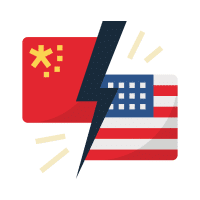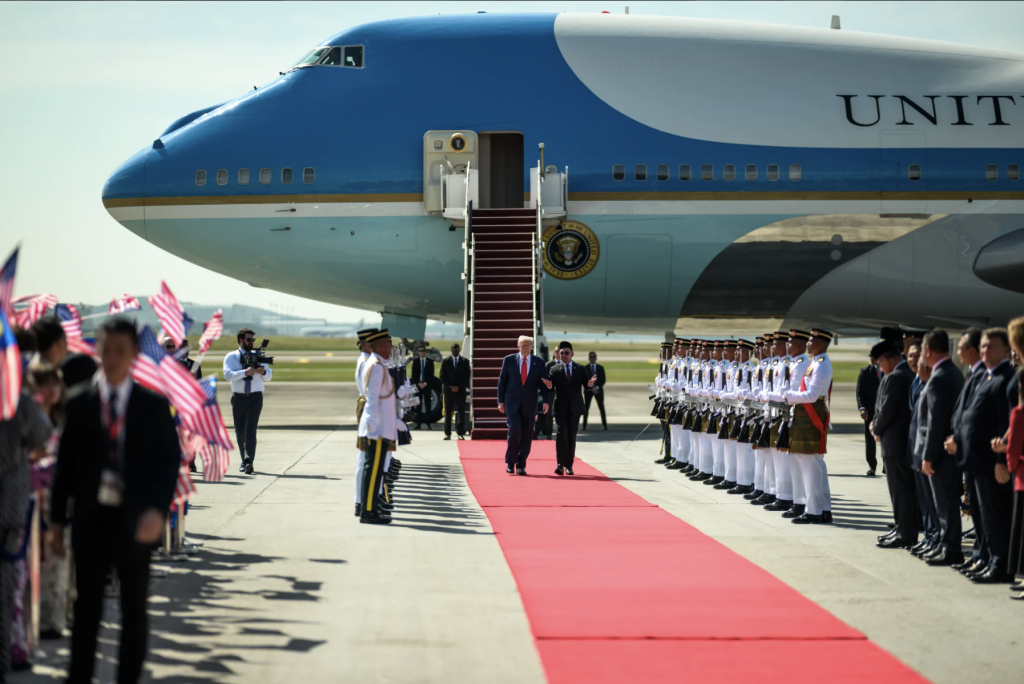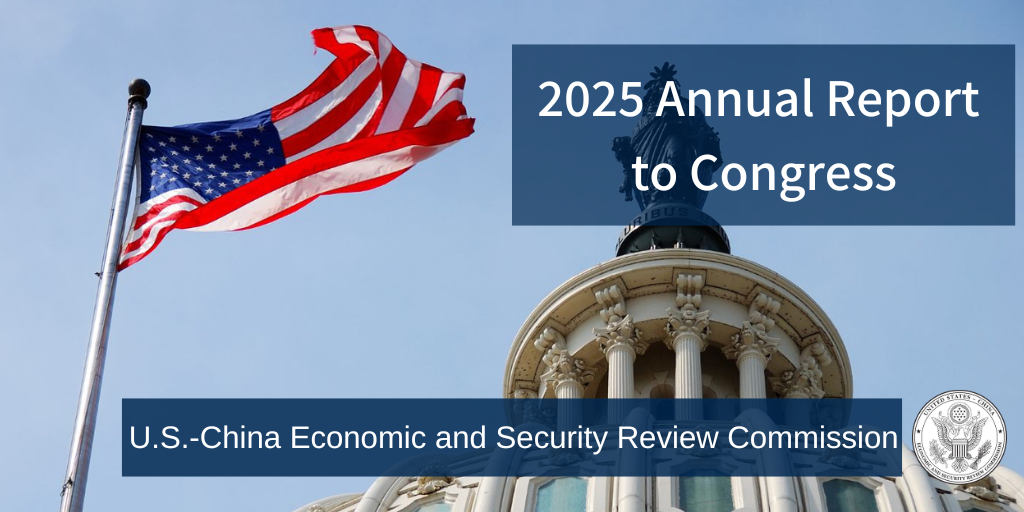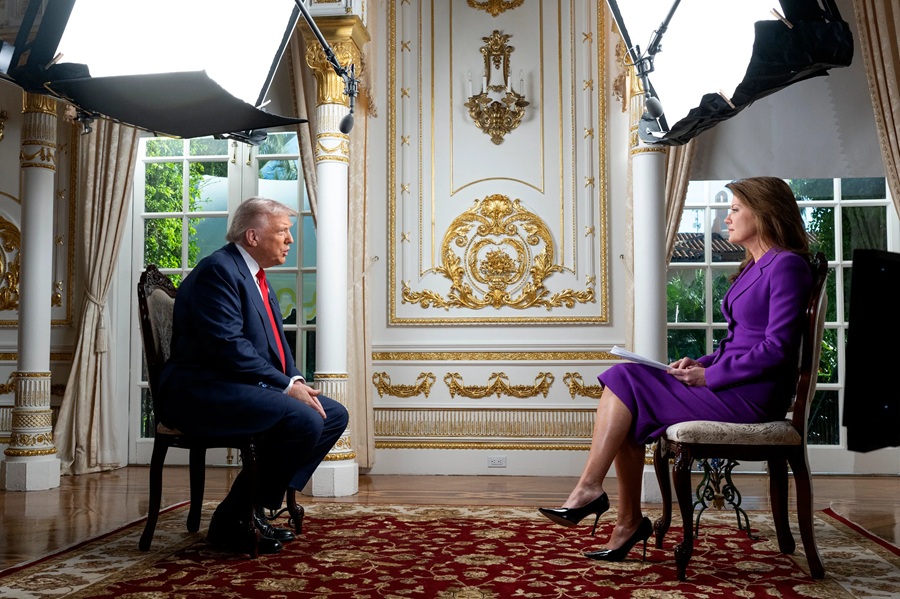达巍:美国和中国可以拥有一种正常关系
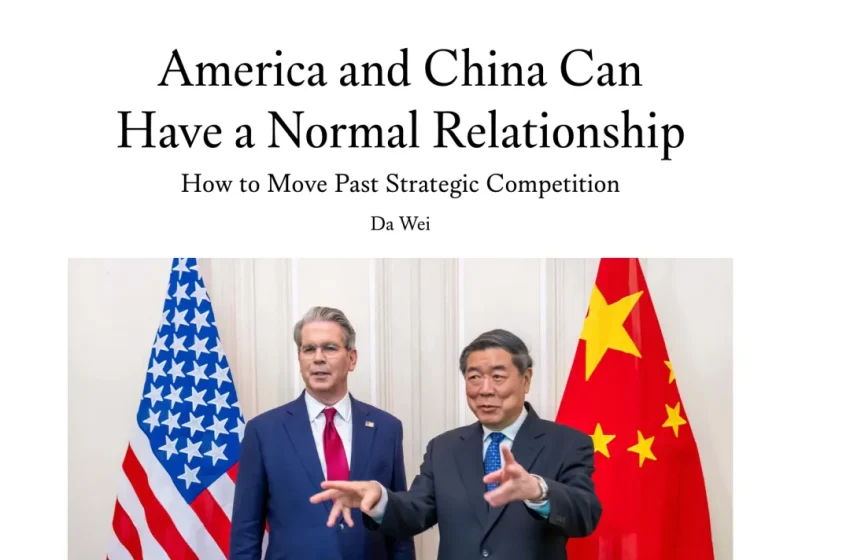
本文英文版2025年10月30日在美国《外交事务》杂志发表,英文题目和副标题为“America and China Can Have a Normal Relationship–How to Move Past Strategic Competition”,中文由清华大学国际战略与安全中心微信公号发布,本站特转发供读者参考。
在一再重复的中美对抗与缓和的循环中,一种矛盾的现象正在浮现。一方面,中美经济关系比以往任何时候都更为紧张:10月上旬,美国和中国在短短的六个月内第二次濒临贸易战,双方都准备实施严厉的出口管制,并威胁将自对方进口商品的关税提升至前所未有的水平。另一方面,中美关系却也显现出更强的韧性。尽管华盛顿和北京似乎都对全球两大经济体的脱钩趋势显得无能为力,但4月至5月的贸易摩擦最终让位于一段相对的平静期。在过去十个月中,乃至拜登政府的最后两年里,中美关系都在出现再平衡的迹象。每当危机爆发,例如2023年的无人飞艇事件之后,中美两国领导人都会迅速寻求稳定局势——这说明全球最大的两大经济体仍然在结构性上需要一种总体稳定的关系。
中美关系或许正处在一个转折点。无论华盛顿还是北京,都不再幻想两国能回到2017年前以“相互依存”与“接触”为特征的旧时代。然而,短期的经济摩擦与策略性博弈不应掩盖这样一种可能:美国与中国完全可以超越敌对竞争的阶段,建立一种更为“正常”的关系,一种冷而不僵、竞争但可共处的关系。本周在韩国举行的习近平主席与特朗普总统的会晤,将给中美关系提供一个虽窄却关键的契机,使其进入新的阶段。
美国vs.全世界
转折点的出现,部分源于美国外交政策的变化。在北京看来,特朗普的第一任期标志着战略竞争时期的开始。彼时,美国将中国视为最严峻的对手与竞争者,核心目标是遏制和减缓中国的经济与技术崛起。换言之,那是“美国vs.中国”的时期。拜登政府延续了这一目标,但更倾向于通过联合盟友来实现,这一阶段可以被称为“西方vs.中国”的时期。中国战略界普遍认为, 无论是特朗普还是拜登,两人都认定中美利益根本对立,因此唯一的选项便是毫不妥协的斗争,几乎没有妥协空间。
尽管特朗普在第二任期继续向中国施压,但美国外交出现了明显的再平衡。特朗普正在重新调整美国与世界的经济与安全关系。其4月2日宣布的所谓“解放日关税”波及百余国,包括许多盟友。特朗普政府反复要求欧洲盟友承担更多防务成本,即便因此损害传统关系也在所不惜。如今,美国的做法不再是“美国及其盟友vs.中国”,而更接近于“美国vs.世界其他国家”。
历史上,中美总是拥有一个整体性的合作基础。由于有这个基础,具体分歧就相对容易管控。上世纪七八十年代,中美两国联手应对苏联威胁;冷战结束后,两国共同推动经济全球化并共享收益。但在过去十年,随着各国逐渐远离全球化,中美合作的根基不断削弱。如今,特朗普政府几乎完全否定旧的全球化模式,并将外交重点从“针对中国”转向“重塑对所有国家的政策”,这反而为中美关系建立新的基础创造了机会。
全球化之后
无论华盛顿还是北京的战略家与决策者,往往都将过去十年中美关系的恶化归咎于对方的敌意政策。但另一种解释是——旧的全球化模式本身已无法为继。两国关系的恶化,更多地是结构性转变的结果,而非相反。
在美国主导的冷战后自由国际秩序中,中国取得了惊人的发展。然而,中国以不同于西方自由主义的政治经济模式崛起,这事实上将自由主义秩序撑薄到了其极限。与此同时,美国虽也从单极自由体系中获益颇丰,却未能通过政治手段解决全球化给其国内带来的经济与社会失衡,最终引发了强烈的内部反弹。
今天,美国正在拆解自己曾经主导的体系。无论民主党还是共和党,越来越多的美国政治力量都在背离自由国际主义,转而拥抱产业政策与经济民族主义。如今的中美两国都不再单纯为了追求经济效率而接受对对方金融体系、关键产品与先进技术的无条件依赖。去全球化的进程已无法阻止,各国只能学会适应。
中国的自信心的上升或许也有助于适应这一变化。尽管美国通过出口管制限制中国半导体等产业的发展,中国仍在持续实现技术突破。中国经济增速放缓,但仍保持增长态势;同时,北京也找到反制手段,如管控稀土磁体出口,从而影响美国关键产业。自信的中国更可能将关注重点放在国内稳健的经济政策上,而非过度忧虑外部压力。未来,中国不仅能继续发展前行,而且其在全球相较于美国的地位还可能得到进一步提高。
在此背景下,中美两国的决策者迎来了罕见的“降温”机会。北京可重新审视:美国是否真的是一心地要阻止中国崛起?华盛顿也可反思:中国是否真意在颠覆美国领导的秩序?这种叙事上的调整,有助于两国摆脱敌意,从而恢复更具建设性的互动。
再平衡的路径
美国与中国不必成为朋友,但必须避免成为敌人。建立一种新的关系,意味着重新平衡两国的相互依存方式。
几十年来,中美经济联系实际上是高度不对称的:中国依赖美国的金融体系与高科技以支撑发展,而美国则依赖中国制造业提供廉价消费品。过去十年中美之间的激烈竞争打破了这种旧格局。特朗普政府明确表示,美国不再容忍对华巨额贸易逆差;而中国也对于依赖美国金融与技术优势十分警惕。实际上,早在2018年贸易战爆发前,两国已开始在部分领域“脱钩”。
在一种正常的稳定关系中,中美竞争仍将存在,但其强度需要得到控制。两国应明确哪些领域可以互动、哪些领域应保持独立。中国在电动车与电池制造等领域对美投资,可在产业、技术与金融层面分别形成更平衡的中美相互依存;当然,这种合作只能在双方同意的特定领域进行。这种相互依存更稳固、更可持续,也更容易让双方都感到“受益公平”,并更愿意维持这种平衡。
在地缘政治层面,两国也需重新校准。美国军方频繁在中国沿海进行抵近侦察与所谓“航行自由行动”,强调其合法权利及对盟友的安全承诺,但这些行动实际上极易引发两大军事强国的危险摩擦。美国可通过减少挑衅性活动、利用其他技术手段替代侦察任务,降低军事对抗风险,同时仍能让美国维持其对盟友的承诺。
两国领导人还可在台湾问题上缓和紧张。特朗普政府若能正式重申反对“台独”,将向北京传递关键信号。作为回应,北京可努力减少台海军事紧张并扩大两岸交流。只要北京相信和平统一仍有希望,动武的紧迫性就会下降。这种安排与特朗普“调停长期冲突地区”的全球愿景是一致的。
自1990年代以来,美国总是强调普世使命,而中国则专注国家建设。如今,中美关系首次成为两个民族主义大国的关系:特朗普总统的“让美国再次伟大”与习主席的“中华民族伟大复兴”其实都是民族主义目标,二者并非必然对立。中美完全可以相互成全,或至少互不妨碍。特朗普的“美国优先”也表明,当美国的外交更聚焦于自身时,它往往对中国更为克制,例如在特朗普第二任期的第一年,美国在南海的行动明显降温。
无论是美国还是中国,都无法真正削弱对方的经济,但如果敌对竞争持续失控,双方仍有足够手段给对方造成实质性损害。随着特朗普总统与习主席在韩国重启谈判,中美关系的确具备双边关系再平衡的可能。这一转折并非必然,但它是可能的,也是值得努力追求的目标。
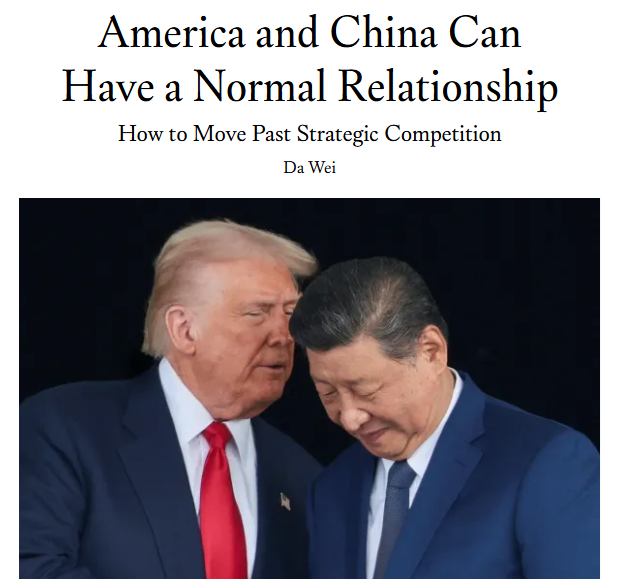
In the repeated cycles of confrontation and détente that define U.S.-Chinese relations, a paradox has emerged. Economic relations between the two countries are more fraught than ever: in early October, for the second time in just six months, the United States and China launched a trade war, imposing prohibitive export restrictions and threatening to raise tariffs to previously unthinkable levels.
Yet the U.S.-Chinese relationship also appears increasingly resilient. Although leaders in both Washington and Beijing have seemingly shrugged their shoulders at the rapid decoupling of the world’s two largest economies, the first bout of trade escalation in April and May gave way to a period of relative calm. Over the past ten months and even during the final two years of the Biden administration, U.S.-Chinese relations have been showing signs of rebalancing. Each time a crisis has arisen, such as when a Chinese unmanned high-altitude balloon flew into American airspace in 2023, U.S. and Chinese leaders have sought to quickly stabilize ties, suggesting that the world’s two largest economies still share a structural need for a broadly steady relationship.
These contradictory trends signal that the U.S.-Chinese relationship might be at an inflection point. Neither Washington nor Beijing harbors any illusions that the two countries can return to the pre-2017 era, in which interdependence and engagement, rather than decoupling and strategic competition, were its defining features. But short-term economic spats and tactical maneuvering for potential deals should not obscure the possibility that the United States and China can move beyond an era of adversarial competition toward a more normal relationship—one in which they can coexist peacefully in a state of cool but not hostile interactions. The meeting between U.S. President Donald Trump and Chinese leader Xi Jinping this week in South Korea presents a narrow but important opportunity for the United States and China to enter a new phase of bilateral relations.
AMERICA VERSUS THE WORLD
The possibility of an inflection point stems in part from changes in U.S. foreign policy. From Beijing’s perspective, Trump’s first term marked the onset of a period of strategic competition in which the United States, viewing China as its most serious adversary and competitor, sought primarily to contain or slow China’s economic and technological rise. It was, in other words, the United States versus China. Under President Joe Biden, Washington maintained the same goals but sought to do so in concert with its allies—the West versus China. For strategists and policymakers in China, both Trump and Biden believed that American and Chinese interests were fundamentally at odds, and therefore the only option was unyielding competition that left no room for compromise.
Although Trump has continued to pressure China in his second term, U.S. foreign policy has shifted. Trump has recalibrated the United States’ economic and security relations with the entire world. His so-called Liberation Day tariffs in April, for instance, targeted more than 100 countries, including many U.S. allies. The Trump administration has repeatedly pressured longtime U.S. partners in Europe to pay for more of their own security, even at the cost of straining ties. Trump’s approach can no longer be characterized as the United States or its allies versus China, but rather the United States versus the rest of the world.
In previous eras, the United States and China found ways to build a foundation on which the two countries could work together despite their disagreements. In the 1970s and early 1980s, they cooperated to counter the Soviet Union. After the Soviet collapse and the end of the Cold War, Beijing and Washington promoted economic integration and shared in the gains of globalization. In the past decade, however, as countries have turned away from globalization, the grounds of cooperation between the United States and China have eroded. But by more fully rejecting the entirety of the old model of globalization—and reorienting its foreign policy strategy away from targeting only China—the Trump administration has created an opportunity to establish a new basis for improved relations.
AFTER GLOBALIZATION
Although strategists and policymakers in Washington and Beijing alike tend to blame the deterioration in U.S.-Chinese relations on hostile policies from the other side, an alternative explanation is that the old model of globalization became unsustainable. Growing friction is a function of structural shifts as much as individual leaders.
China rose spectacularly in the post–Cold War era of liberal internationalism led by the United States. But by relying on a political and economic model distinct from Western liberalism, China’s rise effectively stretched the liberal order to its breaking point. The United States also benefited greatly from a liberal, unipolar world, but it failed to address the dislocation that globalization brought to its own economy and society, leading to intense domestic backlash.
The United States is now dismantling the system it built and led. Many Democrats and Republicans alike have pushed back on liberal internationalism and have instead embraced industrial policy and economic nationalism. Neither the United States nor China now accepts economic efficiency as a justification for dependence on the other side’s financial systems, critical goods, and advanced technologies. Countries cannot halt this process of deglobalization. They can only adapt to it.
China’s growing confidence may make that task easier. In recent years, the United States has imposed significant restrictions on China’s development through export controls on industries such as semiconductors. Yet China has continued to achieve technological breakthroughs. China’s growth rate has slowed, but the economy continues to expand. And Beijing has now found ways to pressure Washington, most notably by controlling the supply of rare-earth magnets on which many U.S. industries rely. A confident China can focus more on implementing sound economic policies at home and less on how U.S. pressure might hinder its goals. By doing so, China will continue to develop and may even improve its global standing relative to the United States.
In this context, policymakers and strategists in both China and the United States have a rare opportunity to temper their attitudes toward each other. Beijing could reconsider whether the United States is intent on thwarting China’s rise. Washington could reassess the dominant perception that China seeks to overthrow U.S. global leadership. A change in narratives will help move past the hostility that has prevented the two sides from working together more productively.
A REBALANCING ACT
The United States and China do not have to be friends, but they do have to avoid being enemies. A new type of relationship requires rebalancing how the two countries depend on each other. For decades, their economic ties were asymmetric: China relied on the United States’ monetary and financial systems, as well as its advanced technology, to fund its growth and provide the know-how it needed to develop its economy. The United States, in turn, depended on Chinese manufacturing to produce low-cost goods to consume. The fierce competition of the past decade has shattered that old pattern. The Trump administration has made clear that the United States will no longer accept a massive trade deficit with China, and Chinese leaders have expressed their uneasiness about reliance on U.S. financial and technological tools. Even before the trade war that broke out in 2018, the two countries had already started to decouple some parts of their economies.
In a relationship characterized by levelheaded stability, competition between the United States and China would endure. But both countries would need to regulate the intensity of the competition and establish clearer lines to demarcate where their economies and societies should interact and where they should be independent. Large-scale Chinese investment in the United States in electric vehicles and batteries, for instance, would make both countries more equally reliant on each other in manufacturing, technology, and finance. But investment should be limited to certain sectors in which both countries agree that collaboration is mutually beneficial. This type of interdependence is more stable—and likely more sustainable—than one in which the United States provides high-value inputs and China produces low-value outputs. Both sides would be more likely to feel they are benefiting from the economic relationship and seek to preserve the balance.
The two countries also need to recalibrate their geopolitical relations in the Indo-Pacific. The U.S. military routinely conducts reconnaissance missions and freedom of navigation operations near China’s coastline, insisting on its legal right to do so and the necessity of reassuring its regional allies of its security commitments. But these actions risk provoking a dangerous conflict between the world’s two largest military powers. The United States could lower regional tensions by reducing the frequency of these politically provocative actions. Instead, the United States could employ other technological means, such as satellites, to gather military intelligence, which would reduce the risk of military confrontation while allowing it to uphold its security commitments.
U.S. and Chinese leaders can also de-escalate tensions around Taiwan. The Trump administration could reassure Beijing of its position on the island’s future by formally opposing Taiwanese independence. In response, Beijing could reduce the frequency of military exercises and increase cross-strait exchanges. If leaders in Beijing believe there is hope for peaceful reunification, there is less urgency to use military force to resolve the question of Taiwan’s status. This arrangement aligns with Trump’s global vision of trying to broker peace in areas of long-standing conflict.
From the 1990s until this year, the United States prioritized a universal outlook, whereas China focused on nation building. Now, for the first time in decades, the U.S.-Chinese relationship involves two nationalist powers. Trump’s call to “Make America Great Again” and Xi’s vision of the “great rejuvenation of the Chinese nation” are both nationalist goals. Such nationalist visions are not necessarily in conflict. Instead, the United States and China can support each other’s rejuvenation, or at the very least, avoid impeding the other’s progress toward that goal. Trump’s “America first” approach suggests this is possible: when the United States focuses on itself in its foreign policy, it is often more restrained toward China, as has been the case in the South China Sea in the first year of Trump’s second term.
Neither the United States nor China can fully hobble each other’s economy, but each side has economic tools that can inflict real damage if adversarial competition continues unchecked. As Trump and Xi head to the negotiating table, the conditions are ripe for an inflection point in U.S.-Chinese relations that could set a path toward a more stable and effective relationship. Such a course correction is far from guaranteed. But it is a possible and worthy goal.

